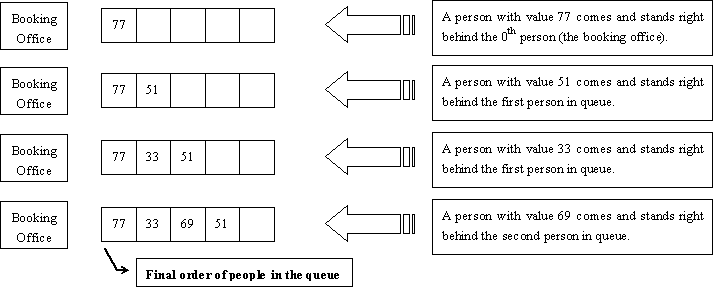Buy Tickets
| Time Limit: 4000MS | Memory Limit: 65536K | |
| Total Submissions: 26443 | Accepted: 12639 |
Description
Railway tickets were difficult to buy around the Lunar New Year in China, so we must get up early and join a long queue…
The Lunar New Year was approaching, but unluckily the Little Cat still had schedules going here and there. Now, he had to travel by train to Mianyang, Sichuan Province for the winter camp selection of the national team of Olympiad in Informatics.
It was one o’clock a.m. and dark outside. Chill wind from the northwest did not scare off the people in the queue. The cold night gave the Little Cat a shiver. Why not find a problem to think about? That was none the less better than freezing to death!
People kept jumping the queue. Since it was too dark around, such moves would not be discovered even by the people adjacent to the queue-jumpers. “If every person in the queue is assigned an integral value and all the information about those who have jumped the queue and where they stand after queue-jumping is given, can I find out the final order of people in the queue?” Thought the Little Cat.
Input
There will be several test cases in the input. Each test case consists of N + 1 lines where N (1 ≤ N ≤ 200,000) is given in the first line of the test case. The next N lines contain the pairs of values Posi and Vali in the increasing order of i (1 ≤ i ≤ N). For each i, the ranges and meanings of Posi and Vali are as follows:
- Posi ∈ [0, i − 1] — The i-th person came to the queue and stood right behind the Posi-th person in the queue. The booking office was considered the 0th person and the person at the front of the queue was considered the first person in the queue.
- Vali ∈ [0, 32767] — The i-th person was assigned the value Vali.
There no blank lines between test cases. Proceed to the end of input.
Output
For each test cases, output a single line of space-separated integers which are the values of people in the order they stand in the queue.
Sample Input
4 0 77 1 51 1 33 2 69 4 0 20523 1 19243 1 3890 0 31492
Sample Output
77 33 69 51 31492 20523 3890 19243
Hint
The figure below shows how the Little Cat found out the final order of people in the queue described in the first test case of the sample input.

题意:买票的时候有n个人插队,输入每个人插队的位置pos和插队的时间val,如果两个人同一个位置,时间小的在前面,按从前到后输出队伍最后的排列顺序
题解:先初始化线段树,第i个位置前面有i个位置,从最后一个数据开始更新线段树,每处理完一个数据,空位置数减一,处理到最后即可
输入样例eg:
空 空 空 空
空 空 空 69
空 空 33 69
空 空 33 51 69//在33和69之间插入,没有占用位置
空 77 33 51 69
注:用cin的话,就算用加速一样会超时
#include<iostream> #include<string.h> #include<string> #include<stdio.h> using namespace std; int n; int tree[2000005], pos[200005], val[200005], ans[200005]; void build(int num, int le, int ri) { tree[num] = ri - le + 1;//初始化空格数量 if (le == ri) { return; } int mid = (le + ri) / 2;//mid设为全局变量答案就错了 build(num * 2, le, mid); build(num * 2 + 1, mid + 1, ri); } void update(int num, int le, int ri, int x, int y) { tree[num]--;//占用之后空格数减一; if (le == ri) { ans[le] = y; return; } int mid = (le + ri) / 2; if (x <= tree[num * 2]) update(num * 2, le, mid, x, y); else update(num * 2 + 1, mid + 1, ri, x - tree[num * 2], y); } int main() { // ios::sync_with_stdio(false); while (~scanf("%d",&n)) { for (int i = 1; i <= n; i++) { scanf("%d%d",&pos[i],&val[i]); pos[i] = pos[i] + 1;//初始化,i位置(包括i)前有几个空位置 } build(1, 1, n); for (int i = n; i >= 1; i--)//从最后一个人开始插队 { update(1, 1, n, pos[i], val[i]); } for (int i = 1; i <= n; i++) { if (i == 1) printf("%d",ans[i]); else printf(" %d",ans[i]); } printf(" "); } return 0; }